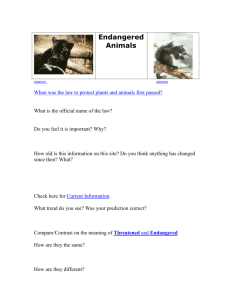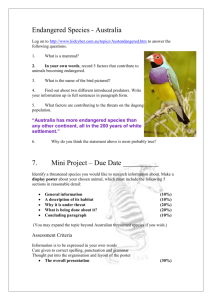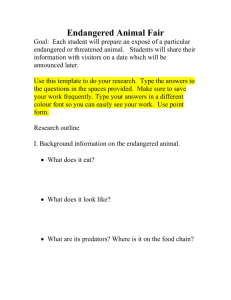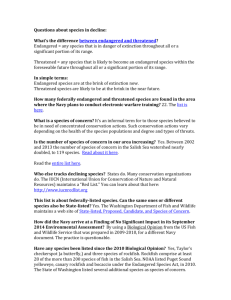DOC - Europa
advertisement
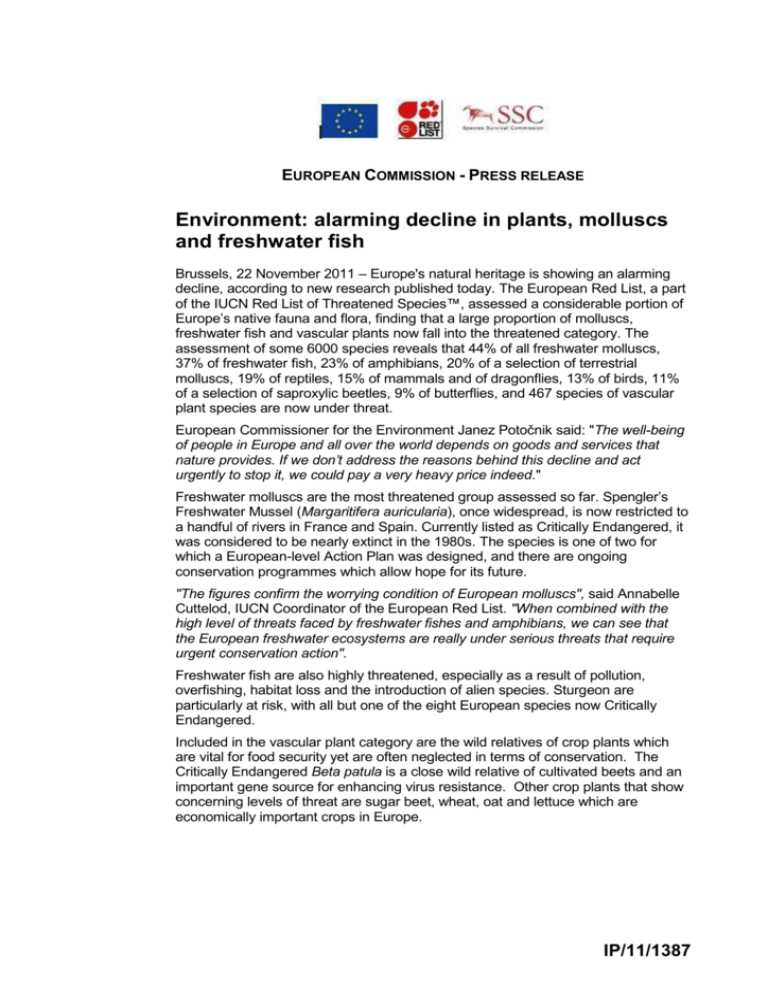
EUROPEAN COMMISSION - PRESS RELEASE Environment: alarming decline in plants, molluscs and freshwater fish Brussels, 22 November 2011 – Europe's natural heritage is showing an alarming decline, according to new research published today. The European Red List, a part of the IUCN Red List of Threatened Species™, assessed a considerable portion of Europe’s native fauna and flora, finding that a large proportion of molluscs, freshwater fish and vascular plants now fall into the threatened category. The assessment of some 6000 species reveals that 44% of all freshwater molluscs, 37% of freshwater fish, 23% of amphibians, 20% of a selection of terrestrial molluscs, 19% of reptiles, 15% of mammals and of dragonflies, 13% of birds, 11% of a selection of saproxylic beetles, 9% of butterflies, and 467 species of vascular plant species are now under threat. European Commissioner for the Environment Janez Potočnik said: "The well-being of people in Europe and all over the world depends on goods and services that nature provides. If we don’t address the reasons behind this decline and act urgently to stop it, we could pay a very heavy price indeed." Freshwater molluscs are the most threatened group assessed so far. Spengler’s Freshwater Mussel (Margaritifera auricularia), once widespread, is now restricted to a handful of rivers in France and Spain. Currently listed as Critically Endangered, it was considered to be nearly extinct in the 1980s. The species is one of two for which a European-level Action Plan was designed, and there are ongoing conservation programmes which allow hope for its future. "The figures confirm the worrying condition of European molluscs", said Annabelle Cuttelod, IUCN Coordinator of the European Red List. "When combined with the high level of threats faced by freshwater fishes and amphibians, we can see that the European freshwater ecosystems are really under serious threats that require urgent conservation action". Freshwater fish are also highly threatened, especially as a result of pollution, overfishing, habitat loss and the introduction of alien species. Sturgeon are particularly at risk, with all but one of the eight European species now Critically Endangered. Included in the vascular plant category are the wild relatives of crop plants which are vital for food security yet are often neglected in terms of conservation. The Critically Endangered Beta patula is a close wild relative of cultivated beets and an important gene source for enhancing virus resistance. Other crop plants that show concerning levels of threat are sugar beet, wheat, oat and lettuce which are economically important crops in Europe. IP/11/1387 But there is some positive news, and the assessment highlights the success of welldesigned conservation measures. Many species protected under the EU Habitats Directive and included in the Natura 2000 network of protected areas now have an improved chance of survival. Centranthus trinervis, a plant endemic to Corsica, has been downlisted from Critically Endangered to Endangered due to strict protection of its single known site. Additionally, the control of invasive species such as plants, goats and rats for example has benefited the majority of threatened land snails in Madeira over the past 10 years. Background The European Red List – compiled using the same criteria as the global IUCN Red List of Threatened Species™, but limited to Europe – is a review of the conservation status of c. 6,000 European species (mammals, reptiles, amphibians, freshwater fishes, butterflies, dragonflies, and selected groups of beetles, molluscs, and vascular plants). It identifies species that are threatened with extinction at the regional level so that conservation action can be taken to improve their status. The European Red List is primarily funded by the European Commission. Species are assigned to one of eight categories of threat. Species listed as Critically Endangered, Endangered or Vulnerable are collectively described as ‘Threatened’. The list was compiled by IUCN’s Global Species Programme, the IUCN Regional Office for Europe, the IUCN Species Survival Commission and its expert network, as well as several partners, including Butterfly Conservation Europe, the European Invertebrates Survey, and the Natural History Museum of Bern (Switzerland). The EU is responding to the threats facing freshwater fish, molluscs and other forms of biodiversity with a new Biodiversity Strategy adopted in May this year. The ambitious new strategy aims to halt the loss of biodiversity and ecosystem services in the EU by 2020. There are six main targets, and 20 actions to help Europe reach its goal. The targets cover: - Full implementation of EU nature legislation to protect biodiversity Better protection for ecosystems, and more use of green infrastructure More sustainable agriculture and forestry Better management of fish stocks Tighter controls on invasive alien species A bigger EU contribution to averting global biodiversity loss Further information: For full details, see http://ec.europa.eu/environment/nature/conservation/species/redlist and http://www.iucnredlist.org/europe. High-resolution photos may be downloaded from http://tinyurl.com/cecpg5c VNR material is available from tvlink.org Contacts : Joe Hennon (+32 2 295 35 93) Monica Westeren (+32 2 299 18 30) 2
